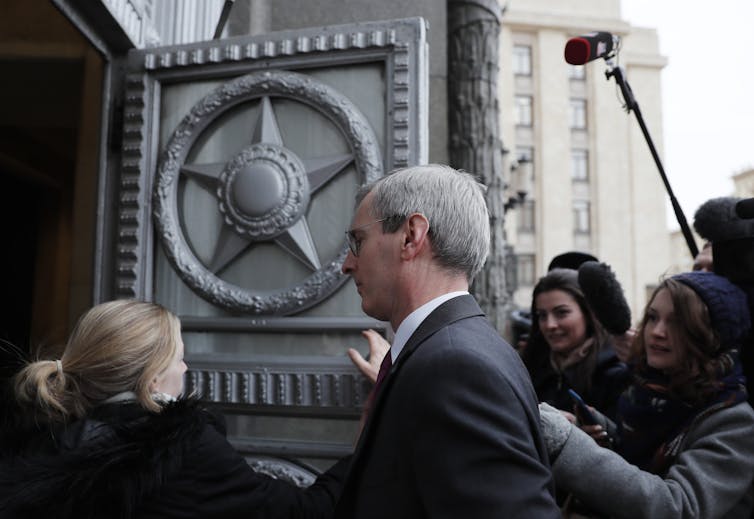The nerve agent, Novichok, used to attack a former Russian spy Sergei Skripal and his daughter in Salisbury is similar to substances such as soman or sarin used to produce chemical weapons. International law bans chemical weapons through the 1992 Chemical Weapons Convention, which requires its 192 state signatories to refrain from using, producing and stockpiling them.
So, with this ban in place, how is it possible that someone could use a nerve agent to attack two people?
The convention defines chemical weapons as toxic chemical substances employed in an unlawful way, contrary to the convention. It aims to prohibit the use, production and possession of chemical weapons, and also requires the destruction of chemical weapons and their production facilities.
Read more: Nerve agents: what are they and how do they work?
Toxic chemical substances are not prohibited per se: it is their association with a forbidden purpose that makes them a chemical weapon, subject to the regulations of the convention. Despite the fact that toxic chemicals could be used to make chemical weapons, they are not subject to the same strict regulations as chemical weapons, such as the prohibition of their use or transfer. Instead, they are subject to verification measures and to limits on their production and storage.
An inherent paradox
The convention perfectly mirrors the paradox behind chemical weapons. These powerful weapons are made up of substances that are often easy to produce. Some, such as chlorine, contained in drugs as hydrochloric acid, are even used in medicine, agriculture or industry. For instance, toxic chemicals can be found during research for new pesticides. This means that what makes the difference between a toxic chemical substance and a chemical weapon is the purpose behind its use.
This logic can also apply to more ordinary objects, such as a knife or drug. A person can use a knife to slice some bread, while a doctor can administer a drug to treat a patient. However, if those items fall into the wrong hands, they can be used to kill or seriously harm someone. In light of the dual use of these items, the law cannot completely ban knives and drugs. What it can do is to establish precautions that minimise the risk of knives and drugs being used in an unlawful way. The same logic applies to the use of toxic chemical substances.
According to Theresa May’s statement to MPs on March 12, the substance used in the Salisbury attack – Novichok – was a nerve agent similar to toxic substances that are already regulated by the Convention on Chemical Weapons, but it is not banned under it. The prime minister said the substance belongs to a category of toxic chemical, which she termed a “military-grade nerve agent of a type developed by Russia”.

Getting round the law
The rules of the convention regarding toxic chemical substances do not apply in this case, due to the fact that there was nothing to regulate.
This just shows how important international cooperation and transparency among countries on this issue are. International legal instruments on weapons cannot function without constant updates regarding chemical production and new technological developments. The convention requires states to share the details about any production of chemicals with the Organisation for the Prohibition of Chemical Weapons, the body in charge of the enforcement of the convention. States must declare information including the type of chemical that will be produced and the quantity. Such a declaration should have been done before Novichok was produced.
After the discovery of a new chemical, the convention provides guidelines for updating its lists of chemicals, along with a speedy procedure to amend the relevant section of the convention.
Another issue concerns the military nature of the nerve agent used in Salisbury. Toxic chemicals can be produced and used for lawful purposes according to the convention, including for military, defence and protection reasons. It’s just the use of toxic chemicals as a method of warfare that is strictly prohibited.
If whoever produced Novichok had followed the provisions of the convention, and had disclosed details such as its name and the structural formula of the chemical, the nerve agent used in Salisbury would not actually have been banned. It would simply have been subjected to the limitations and the verification procedures of the convention that apply to other toxic substances. This is because the 1992 convention bans chemical weapons but does not prohibit the use of toxic chemical substances for peaceful or acceptable purposes.
It seems that whoever produced, and used Novichok to attack the Skripals, did not want to share information about this substance and the facilities able to produce it – in disregard of international law.
Good faith and transparency are essential for the functioning of the international law on chemical weapons – both of which currently appear to be lacking.

